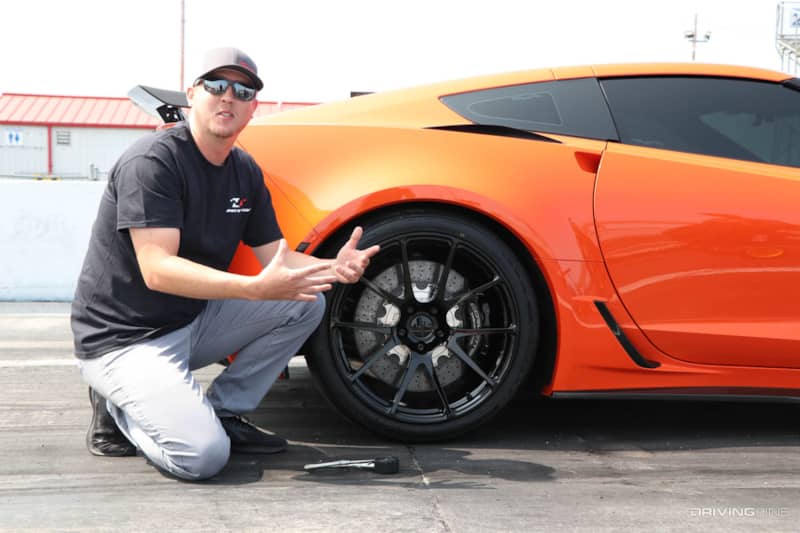How to Run Nitto NT555RII DOT-Compliant Drag Radial Tires at the Drag Strip
Justin Keith owns Killer Performance in Kansas City, Missouri and stepped up to show us what it takes to have a great day at the drag strip with Nitto NT555RII drag radials. He brought his 2019 Corvette ZR1 to World Wide Technology Raceway and dove into the four basic steps to get the best launches possible on Nitto NT555RII DOT-compliant drag radials.

The new tires are great for daily driving and they're also awesome on the track, and they're designed to match the look and tread pattern of the NT555 G2 street tire for the front. Plus the NT555RII tire features an improved compound over its NT05R counterpart and a stiffer sidewall as well. More good news is that you don't have to change wheels to run at the track, but you do need to play with the tire pressure to get the most traction out of the tire.

Prep Schooled
The first consideration for drag racing tires is, of course, the surface. You usually run into two basic types of track preparation. First, there's radial prep for specialty events; it's also typical at Street Car Takeover. Radial prep tracks are very sticky and almost look wet when viewed on the horizon. The second are test-and-tune prep tracks. They have a flatter/duller look because they're not so heavily prepped as radial prepared surfaces. You also use different strategies for racing on both surfaces. More on that later.

Pressure Points
Tailoring your tire pressure to the driving surface can make a huge difference at the strip. To maximize traction at the drag strip, Justin gets his best results with the NT555R2 at 18-20 PSI on a good, radial prepped track. On a test-and-tune or no-prep strip, you'll want to drop the pressure into the 13-16 PSI range. When you get to the track, start at 20 PSI and scale down to what works best for those particular surface conditions. Of course, none of this matters without a tire pressure gauge to measure your psi. That's why Justin keeps one in the glove box of his Corvette at all times.

Once you've made a few runs, take a look at your tire wear. It should be even across the width of the tire. If it's wearing more on the outside and not so much on the center, your pressure may be too low. Just bump it up a few PSI and your tires will respond in kind. On the other hand, if you're getting more wear in the center than on the outside, your pressure is running too high and you'll want to drop it down the PSI down a bit. Regardless, once the tire pressure is dialed in, you should have good consistent launches down the strip.
To Bead Lock, Or Not to Bead Lock. That is the Question.
As Justin points out, there's some debate over whether or not to run a bead lock for drag racing. He recommends chalk testing. Put a line of chalk on your wheel and line it up with your tire. Make a pass, then see if the two are still lined up. If not, you have some slippage going on and you may need a bead lock at some point in the future. Imagine a sprinter at the blocks before a race. If his/her track shoes slip at launch, some of that kinetic energy slips with them. A bead lock prevents your tires from rotating on their wheels at launch, so that all of that energy goes from the tires to the surface, thus giving you a better launch.

Burn Notice
Now that the tire pressure is all set, let's move on to the fun part: melting rubber in a fiery flurry of friction. On a new set of NT555RII tires, opening up with a good, solid burnout is a good idea. Justin prefers pulling through the water box, hit a good burnout, then roll forward from first gear into second, and roll out of it as he's letting off the throttle. When you roll out, listen for the tires to make a chirping sound. It tells you that the tires are cleaned off and ready to rock. Bear in mind that when your tires heat up the air in them expands and it make kick your PSI up one or two ticks. You may want to double check your pressure at this point and adjust it back down to where the PSI was when the tires were colder.

Resist the strong urge to bust out too big of a burnout, though. Doing so makes the track feel greasy and you'll spin the tires off the line. Hitting a lighter burnout before the next run should take care of that, though. Having said that, bigger burnouts are a good plan at a no-prep strip where the surface is harder. That's because you want to make your tires stickier to compensate for the harder conditions.

On a radial prepped track, the opposite holds true: run lighter burnouts but hard enough to make sure you get the tires cleaned off completely. That should give you the best launch conditions possible.
Launch Time
Here's where the rubber actually meets the road. Or in this case, the strip. Everything we've talked about sets the stage for a good launch. On higher horsepower rides like Justin's you want to roll the throttle soft at first, until you feel the tires hook up. That's when you give them all the power you've got. For cars running lower horsepower (400-500 hp), nail it off the line, my friend. Those tires will hook right away and send you down the line just like you want.

I Got My Nine
Applying what he'd talked about, Justin took his Corvette down the quarter mile drag strip into the low 10s and one pass in nine second territory on his Nitto NT555RII DOT compliant drag radial tires. Hopefully, with this knowledge to help you, you will too.












